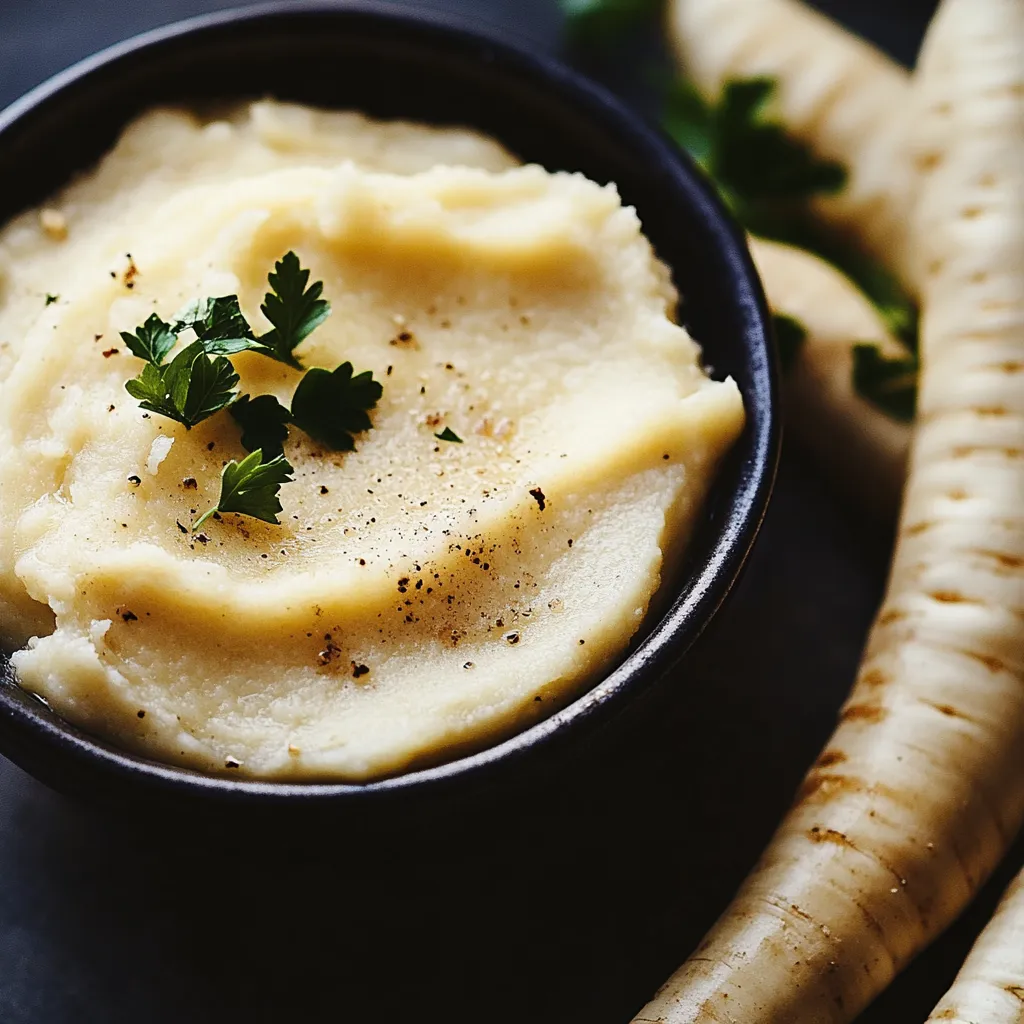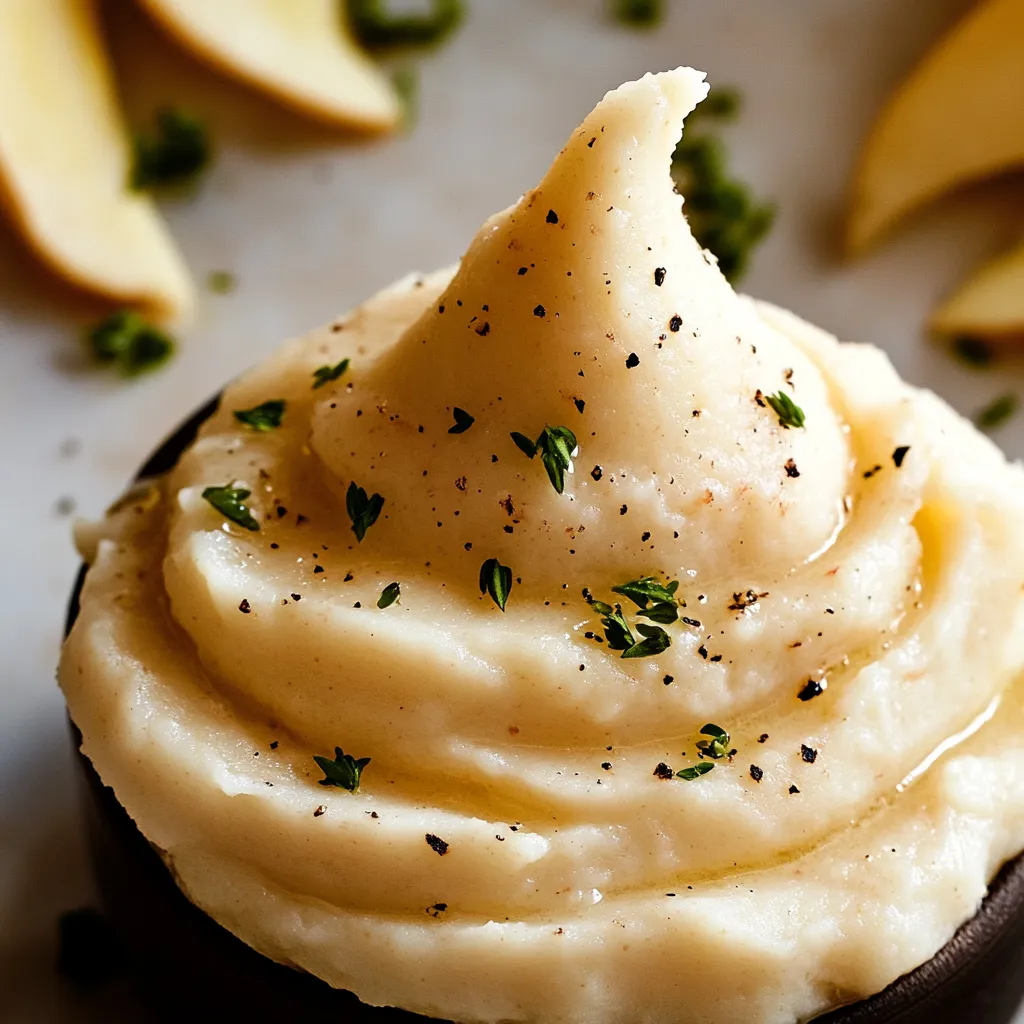 Pin it
Pin it
This luxurious parsnip puree transforms an often-overlooked root vegetable into a silky, restaurant-worthy side dish that rivals even the best mashed potatoes. The recipe balances the natural sweetness of parsnips with rich butter and aromatic herbs for an elegant accompaniment to any main course.
I first made this parsnip puree for a holiday dinner when I wanted something more interesting than standard sides. The compliments were immediate, and it has become my secret weapon for elevating weeknight meals and special occasions alike.
Ingredients
- Parsnips: Fresh ones with firm texture provide the sweetest flavor and smoothest puree
- Milk: Whole milk works best for creaminess without being too heavy
- Heavy cream: Adds luxurious richness that transforms the texture
- Garlic cloves: Gently smashed to infuse flavor without overwhelming
- Fresh thyme: The aromatic quality pairs perfectly with parsnips natural sweetness
- Bay leaf: Adds subtle depth that many people cant identify but definitely miss if absent
- Unsalted butter: Use high-quality European style if possible for extra richness
- Salt and pepper: Fresh grinding makes a noticeable difference
- Olive oil: A finishing drizzle adds beautiful presentation and flavor contrast
- Fresh parsley: Brightens both the flavor and appearance
Step-by-Step Instructions
- Prepare the parsnips:
- Peel parsnips thoroughly and slice into evenly sized pieces about 1/2-inch thick. Consistent sizing ensures they cook evenly and become tender at the same time, preventing any fibrous bits in your final puree.
- Create the aromatic poaching liquid:
- Add the sliced parsnips to a medium saucepan along with milk, cream, smashed garlic cloves, thyme sprig, bay leaf, and a generous pinch of salt. The combination of milk and cream creates the perfect poaching medium that infuses flavor while gently cooking the parsnips.
- Simmer to tenderness:
- Bring the mixture to a gentle simmer over medium-low heat, being careful not to let it boil over. Cook for 12 to 15 minutes, occasionally stirring gently, until the parsnips are extremely tender when pierced with a fork. They should offer no resistance at all.
- Strain and prepare for blending:
- Once tender, remove the thyme sprig and bay leaf and discard them. Carefully strain the parsnips and garlic, making sure to reserve all the cooking liquid in a separate container. This flavor-infused liquid is crucial for achieving the perfect consistency.
- Blend to silky perfection:
- Transfer the hot parsnips and garlic to a blender along with the butter. Begin blending on low speed, gradually increasing to high. As the mixture blends, slowly pour in just enough of the reserved cooking liquid to achieve a silky smooth consistency. You might not need all the liquid.
- Season and final blend:
- Taste the puree and adjust the seasoning with salt and freshly ground black pepper. Blend once more for about 30 seconds to incorporate the seasonings and ensure absolute smoothness. The puree should be velvety with no fibrous bits.
 Pin it
Pin it
The transformative moment in this recipe is adding the butter while the parsnips are still hot. I discovered that this timing allows the fat to emulsify perfectly with the starch in the parsnips, creating that silky restaurant texture that seems impossible to achieve at home. This simple technique elevates the entire dish.
Perfect Pairings
The subtle sweetness and velvety texture of this parsnip puree makes it an exceptional accompaniment to rich, savory proteins. Try serving it alongside a perfectly seared steak where the contrast between the meat's charred exterior and the puree's silkiness creates a beautiful textural balance. For poultry enthusiasts, this puree forms a luxurious bed for roasted chicken with crispy skin, allowing the meat juices to mingle with the puree. Game meats like venison or duck breast also benefit from parsnip's natural sweetness, which helps temper the meat's distinctive flavors.
Seasonal Variations
Parsnips reach their peak sweetness after the first frost when their starches convert to sugar, making winter the ideal season for this dish. During autumn, try incorporating a small diced apple into the cooking liquid for added sweetness and complexity. Spring variations might include a handful of fresh spring peas blended in for color and freshness. In summer, when parsnips may not be at their best, substitute with a combination of cauliflower and potatoes while maintaining the same cooking technique for a similar texture.
Troubleshooting Tips
The most common issue when making parsnip puree is graininess or stringiness in the final texture. If your parsnips are particularly fibrous, especially larger or older ones, consider passing the puree through a fine mesh sieve after blending for ultimate smoothness. If your puree seems too thin, return it to a clean pot and gently simmer to reduce some moisture rather than adding starch thickeners. Conversely, if it's too thick, warm a bit more cream and gradually incorporate it while stirring. Always taste and adjust seasoning right before serving, as the flavors can mellow when the puree sits.
 Pin it
Pin it
This recipe is proof that with the right technique, even humble ingredients can achieve gourmet results.
Frequently Asked Questions
- → Can I make this parsnip puree ahead of time?
Yes, you can make this puree up to 2 days ahead. Store in an airtight container in the refrigerator. When reheating, avoid the microwave as it can cause the butter to split. Instead, reheat gently in a saucepan over low heat with a splash of milk to maintain the creamy texture.
- → What can I serve with Gordon Ramsay's parsnip puree?
This versatile puree pairs beautifully with roasted pork, seared scallops, or glazed carrots. It also complements other protein mains like beef tenderloin, roast chicken, or pan-seared fish. The creamy texture and subtle flavor make it an excellent base for almost any main dish.
- → Can I substitute any ingredients in this parsnip puree?
Yes, several substitutions work well. You can use all milk instead of cream for a lighter version, swap thyme for rosemary or sage, and use vegetable stock instead of dairy for a vegan option (replacing butter with olive oil). The essential elements are cooking the parsnips until very tender and achieving a smooth consistency.
- → How do I achieve the silkiest texture for my parsnip puree?
For ultra-smooth results, strain the puree through a fine-mesh sieve after blending. Use a high-powered blender rather than a food processor if possible. Also, ensure your parsnips are very tender before blending and add the cooking liquid gradually while blending to control the consistency.
- → Why is my parsnip puree bitter?
Bitterness can come from older parsnips or those stored improperly. To reduce bitterness, ensure you peel parsnips thoroughly and remove the woody core from larger ones. The cream and butter in this recipe also help balance any natural bitterness. You can add a pinch of sugar or a drizzle of honey if needed.
- → How long do parsnips need to cook for the puree?
Parsnips typically need 12-15 minutes of simmering to become tender enough for pureeing. You'll know they're done when you can easily pierce them with a fork. Cooking time may vary slightly depending on how thinly you slice the parsnips.
